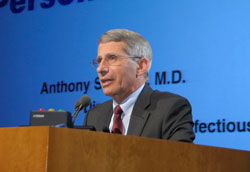Q and A with NIAID Director Dr. Anthony S. Fauci
July / August 2011 | Volume 10, Issue 4

Photo courtesy of NIAID
NIAID Director Dr. Anthony S. Fauci has been
working on HIV/AIDS for three decades.
National Institute of Allergy and Infectious Diseases (NIAID) Director Dr. Anthony S. Fauci has been closely identified with the fight against HIV/AIDS since it began. He admitted his first AIDS patient to the NIH Clinical Center in January 1982. The identification of the human immunodeficiency virus as the cause of AIDS made possible the subsequent development of tests and medications that have improved and lengthened the lives of millions worldwide. Here he reflects on 30 years of the disease.
How did you begin at NIH?
I went to Cornell Medical College in New York City. I had a burning desire to study the interface between infectious diseases and the human immune system, which was not well studied at the time. I came to the NIAID as a clinical associate. My mentor, Dr. Shelly Wolf, put me on an unusual project that led me to study the possibility of suppressing the immune system to effectively treat diseases like Wegener’s granulomatosis.
How did you become involved with HIV?
On June 5, 1981, I was in my office at the Clinical Center when the CDC’s
Morbidity and Mortality Weekly Report landed on my desk and it reported five gay men, from Los Angeles, otherwise healthy, presenting with this strange pneumonia,
Pneumocystis pneumonia, which we used to see in clinical patients with cancer. I was familiar with this and that it was seen only in persons with dramatically suppressed immune systems. I remember putting the issue to the side of my desk, thinking, ‘Wow, what a bizarre curiosity.’ One month later, in July, a second
MMWR report came to my desk, and this time, an additional 26 men had it, again all gay, all seemingly healthy, and not only in LA, but now also in San Francisco and New York City. I remember reading it very clearly. It was the first time in my medical career I actually got goose pimples. I knew something was very wrong. It changed the direction of my career.
How would you describe those early days of the epidemic?
It was an extraordinary time. I call it the dark years of my medical career. Seeing all my patients die was a very sobering experience. I became director of NIAID in 1984 because I wanted to have more of an impact on HIV and infectious diseases. I interacted with Presidents. I interacted with gay activists. Author and activist Larry Kramer is a dear friend who was a long-time nemesis. I remember he wanted to get my attention by writing an open letter to “that incompetent idiot” Dr. Tony Fauci. He needed to stir the pot.
What does the future hold for HIV research?
The Holy Grail is a vaccine. I don’t think that there will be a singular prevention modality. If we are going to put an end to HIV/AIDS, the dynamic will be a combination of prevention modalities. It could be topical microbicides, pre-exposure prophylaxis, male circumcision and even a vaccine. The most daunting challenge of all is trying to find a cure for HIV. I have an idea we might be able to cure at least a fraction of people. It’s probably too much to ask that we will have a universal cure for HIV. But in some cases, we will likely be able to discontinue therapy with a certain fraction of new drugs, working by different mechanisms than the current drugs, by starting people early on therapy so the reservoir of the virus becomes much lower. As I said on World AIDS Day, Dec. 1, 2010, I hope that in the not too distant future, World AIDS Day will be a commemoration of something that happened in the past as opposed to a challenge that we still face today.
More Information
To view Adobe PDF files,
download current, free accessible plug-ins from Adobe's website.